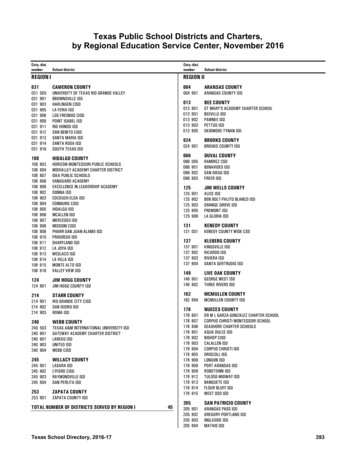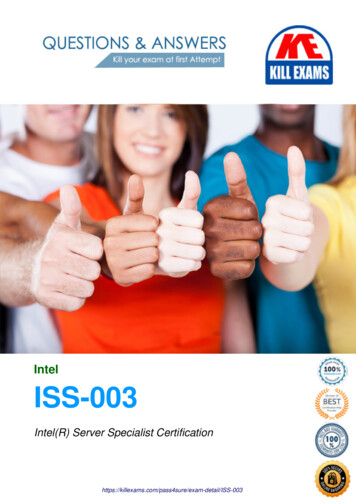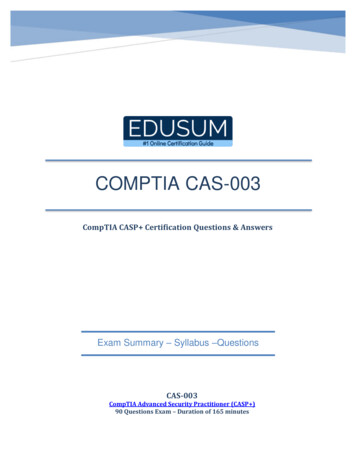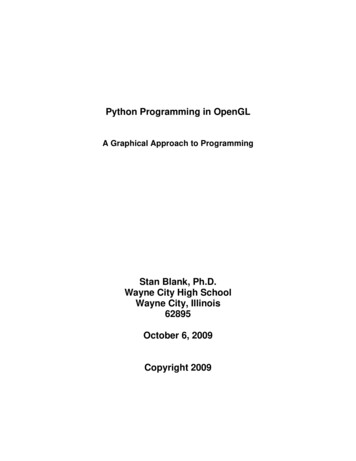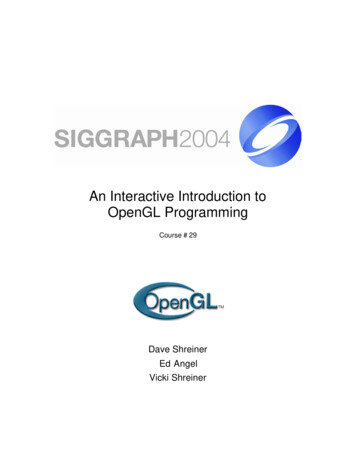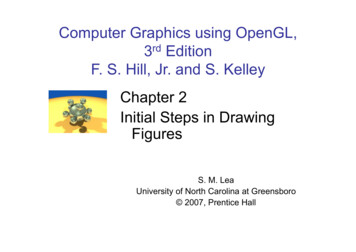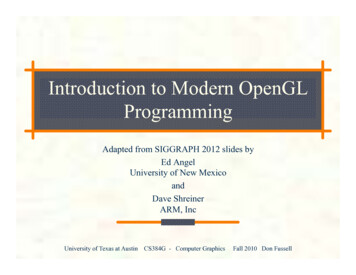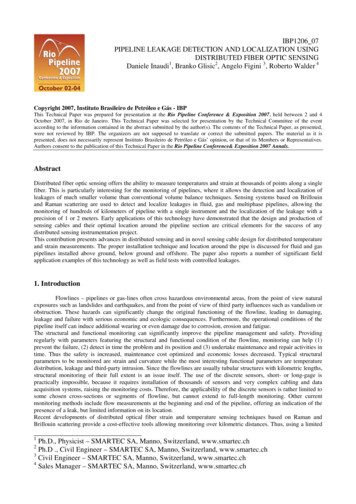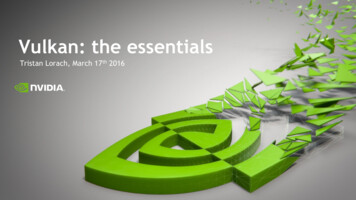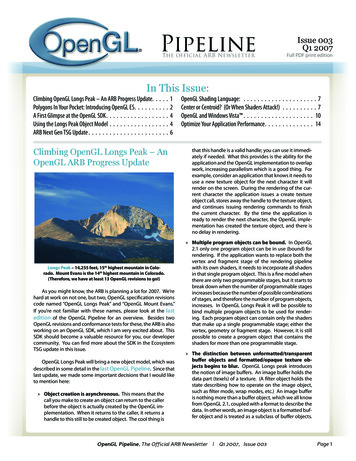
Transcription
PipelineIssue 003Q1 2007The official ARB NewsletterFull PDF print editionIn This Issue:Climbing OpenGL Longs Peak – An ARB Progress Update . . . . . 1Polygons In Your Pocket: Introducing OpenGL ES . . . . . . . . . . 2A First Glimpse at the OpenGL SDK . . . . . . . . . . . . . . . . . . 4Using the Longs Peak Object Model . . . . . . . . . . . . . . . . . 4ARB Next Gen TSG Update . . . . . . . . . . . . . . . . . . . . . . . 6Climbing OpenGL Longs Peak – AnOpenGL ARB Progress UpdateLongs Peak – 14,255 feet, 15th highest mountain in Colorado. Mount Evans is the 14th highest mountain in Colorado.(Therefore, we have at least 13 OpenGL revisions to go!)As you might know, the ARB is planning a lot for 2007. We’rehard at work on not one, but two, OpenGL specification revisionscode named “OpenGL Longs Peak” and “OpenGL Mount Evans.”If you’re not familiar with these names, please look at the lastedition of the OpenGL Pipeline for an overview. Besides twoOpenGL revisions and conformance tests for these, the ARB is alsoworking on an OpenGL SDK, which I am very excited about. ThisSDK should become a valuable resource for you, our developercommunity. You can find more about the SDK in the EcosystemTSG update in this issue.OpenGL Longs Peak will bring a new object model, which wasdescribed in some detail in the last OpenGL Pipeline. Since thatlast update, we made some important decisions that I would liketo mention here:» Object creation is asynchronous. This means that thecall you make to create an object can return to the callerbefore the object is actually created by the OpenGL implementation. When it returns to the caller, it returns ahandle to this still to be created object. The cool thing isOpenGL Shading Language: . . . . . . . . . . . .Center or Centroid? (Or When Shaders Attack!) .OpenGL and Windows Vista . . . . . . . . . . .Optimize Your Application Performance . . . . . . 7. . 7. 10. 14that this handle is a valid handle; you can use it immediately if needed. What this provides is the ability for theapplication and the OpenGL implementation to overlapwork, increasing parallelism which is a good thing. Forexample, consider an application that knows it needs touse a new texture object for the next character it willrender on the screen. During the rendering of the current character the application issues a create textureobject call, stores away the handle to the texture object,and continues issuing rendering commands to finishthe current character. By the time the application isready to render the next character, the OpenGL implementation has created the texture object, and there isno delay in rendering.» Multiple program objects can be bound. In OpenGL2.1 only one program object can be in use (bound) forrendering. If the application wants to replace both thevertex and fragment stage of the rendering pipelinewith its own shaders, it needs to incorporate all shadersin that single program object. This is a fine model whenthere are only two programmable stages, but it starts tobreak down when the number of programmable stagesincreases because the number of possible combinationsof stages, and therefore the number of program objects,increases. In OpenGL Longs Peak it will be possible tobind multiple program objects to be used for rendering. Each program object can contain only the shadersthat make up a single programmable stage; either thevertex, geometry or fragment stage. However, it is stillpossible to create a program object that contains theshaders for more than one programmable stage.» The distinction between unformatted/transparentbuffer objects and formatted/opaque texture objects begins to blur. OpenGL Longs peak introducesthe notion of image buffers. An image buffer holds thedata part (texels) of a texture. (A filter object holds thestate describing how to operate on the image object,such as filter mode, wrap modes, etc.) An image bufferis nothing more than a buffer object, which we all knowfrom OpenGL 2.1, coupled with a format to describe thedata. In other words, an image object is a formatted buffer object and is treated as a subclass of buffer objects.OpenGL Pipeline, The Official ARB Newsletter Q1 2007, Issue 003Page
PipelineThe official ARB Newsletter» A shader writer can group a set of uniform variablesinto a common block. The storage for the uniform variables in a common block is provided by a buffer object.The application will have to bind a buffer object to theprogram object to provide that storage. This providesseveral benefits. First, the available uniform storage willbe greatly increased. Second, it provides a method toswap sets of uniforms with one API call. Third, it allowsfor sharing of uniform values among multiple programobjects by binding the same buffer object to differentprogram objects, each with the same common blockdefinition. This is also referred to as “environment uniforms,” something that in OpenGL 2.1 and GLSL 1.20 isonly possible by loading values into built-in state variables such as the gl ModelViewMatrix.We are currently debating how we want to provide interoperability between OpenGL 2.1 and OpenGL Longs Peak. Our latestthinking on this is as follows. There will be a new context creationcall to indicate if you want an OpenGL 2.1 context or an OpenGLLongs Peak context. An application can create both types of contexts if desired. Both OpenGL 2.1 and Longs Peak contexts canbe made current to the same drawable. This is a key feature, andallows an application that has an OpenGL 2.1 (or earlier) rendering pipeline to open a Longs Peak context, use that context todraw an effect only possible with Longs Peak, but render it intothe same drawable as its other context(s). To further aid in this,there will be an extension to OpenGL 2.1 that lets an applicationattach an image object from a Longs Peak context to a textureobject created in an OpenGL 2.1 context. This image object becomes the storage for the texture object. The texture object canbe attached to a FBO in the OpenGL 2.1 context, which in turnmeans an OpenGL 2.1 context can render into a Longs Peak image object. We would like your feedback on this. Is this a reasonable path forward for your existing applications?The work on OpenGL Mount Evans has also started in earnest.The Next Gen TSG is meeting on a weekly basis to define whatthis API is going to look like. OpenGL Mount Evans will also bringa host of new features to the OpenGL Shading Language, whichkeeps the Shading Language TSG extremely busy. You can findmore in the Next Gen update article in this issue.Another area the ARB is working on is conformance tests forOpenGL Longs Peak and Mount Evans. We will be updating theexisting set of conformance tests to cover the OpenGL ShadingLanguage and the OpenGL Longs Peak API. Conformance testsensure a certain level of uniformity among OpenGL implementations, which is a real benefit to developers seeking a write-once,run anywhere experience. Apple is driving the definition of thenew conformance tests.Lastly, a few updates on upcoming trade shows. We will beat the Game Developer Conference in San Francisco on Wednesday March 7, presenting in more detail on OpenGL Longs Peakand other topics. Watch opengl.org for more information on this!As usual we will be organizing a BOF (Birds of a Feather) at Siggraph, which is in San Diego this year. We have requested ourusual slot on Wednesday August 8th from 6-8pm, but it has not yetbeen confirmed. Again, watch opengl.org for an announcement.Hopefully I’ll meet you at one of these events!In the remainder of this issue you’ll find an introduction toOpenGL ES, updates from various ARB Technical SubGroups,timely information about OpenGL on Microsoft Vista, and an article covering how-to optimize your OpenGL application usinggDEBugger. We will continue to provide quarterly updates ofwhat to expect in OpenGL and of our progress so far.Barthold Lichtenbelt, NVIDIAKhronos OpenGL ARB Steering Group chairPolygons In Your Pocket:Introducing OpenGL ESIf you’re a regular reader of OpenGL Pipeline, you probablyknow that you can use OpenGL on Macs, PCs (under Windows orLinux), and many other platforms ranging from workstations tosupercomputers. But, did you know that you can also use it onPDAs and cell phones? Yes, really!Okay, not really, at least not yet; but you can use its smallersibling, OpenGL ES. OpenGL ES is OpenGL for Embedded Systems, including cell phones in particular, but also PDAs, automotive entertainment centers, portable media players, set-topboxes, and -- who knows -- maybe, someday, wrist watches andCoke machines.OpenGL ES is defined by the Khronos Group, a consortiumof cell phone manufacturers, silicon vendors, content providers,and graphics companies. Work on the standard began in 2002,with support and encouragement from SGI and the OpenGL ARB.The Khronos Group’s mission is to enable high-quality graphicsand media on both mobile and desktop platforms. In additionto OpenGL ES, Khronos has defined standards for high-quality vector graphics, audio, streaming media, and graphics assetinterchange. In 2006, the OpenGL ARB itself became a Khronosworking group, and many ARB members are active in OpenGL ESdiscussions.Why OpenGL ES?When the Khronos group began looking for a mobile 3D API,the advantages of OpenGL were obvious: it is powerful, flexible,non-proprietary, and portable to many different OSes and environments. However, just as human evolution left us with tailbones and appendices, OpenGL’s evolution has left it with somefeatures whose usefulness for mobile applications is, shall wesay, non-obvious: color index mode, stippling, and GL POLYGON SMOOTH antialiasing, to name a few. In addition, OpenGLoften provides several ways to accomplish the same basic goal,and it has some features that have highly specialized uses and/orare expensive to implement. The Khronos OpenGL ES WorkingGroup saw this as an opportunity: by eliminating legacy features,redundant ways of doing things, and features not appropriate formobile platforms, they could produce an API that provides mostof the power of desktop OpenGL in a much smaller package.OpenGL Pipeline, The Official ARB Newsletter Q4 2007, Issue 003Page
PipelineThe official ARB NewsletterDesign GuidelinesLearning MoreThe Khronos OpenGL ES Working Group based its decisionsabout which OpenGL features to keep on a few simple guidelines:In future issues of OpenGL Pipeline, I’ll go into more detailabout the various OpenGL ES versions and how they differ fromtheir OpenGL counterparts. But for the real scoop, you’ll need tolook at the specs. As I said earlier, the current OpenGL ES specifications refer to a parent desktop OpenGL spec, listing the differences between the ES version and the parent. This is great if youknow the desktop spec well, but it’s confusing for the casual reader. For those who prefer a self-contained document, the working group is about to release a stand-alone version of the ES 1.1specification, and (hurray!) man pages. You can find the currentspecifications and (soon) other documentation at http://www.khronos.org/opengles/1 X/.If in doubt, leave it out» Rather than starting with desktop OpenGL and deciding what features to remove, start with a blank piece ofpaper and decide what features to include, and includeonly those features you really need.Eliminate redundancy» If OpenGL provides multiple ways of doing something,include at most one of them. If in doubt, choose themost efficient.“When was the last time you used this?”» If in doubt about whether to include a particular feature, look for examples of recent applications that use it.If you can’t find one, you probably don’t need it.The Principle of Least Astonishment» Try not to surprise the experienced OpenGL programmer; when importing features from OpenGL, don’tchange anything you don’t have to. OpenGL ES 1.0 isdefined relative to desktop OpenGL 1.3 – the specification is just a list of what is different, and why. Similarly,OpenGL ES 1.1 is defined as a set of differences fromOpenGL 1.5.OpenGL ES is almost a pure subset of desktop OpenGL. However, it has a few features that were added to accommodate thelimitations of mobile devices. Handhelds have limited memory,so OpenGL ES allows you to specify vertex coordinates usingbytes as well as the usual short, int, and float. Many handheldshave little or no support for floating point arithmetic, so OpenGLES adds support for fixed point. For really light-weight platforms,OpenGL ES 1.0 and 1.1 define a “light” profile that doesn’t usefloating point at all.To MarketOpenGL ES has rapidly replaced proprietary 3D APIs on mobile phones, and is making rapid headway on other platforms.The original version 1.0 is supported in Qualcomm’s BREW environment for cell phones, and (with many extensions) on the PLAYSTATION 3. The current version (ES 1.1) is supported on a widevariety of mobile platforms.Take It for a Test DriveOpenGL ES development environments aren’t quite as easyto find as OpenGL environments, but if you want to experimentwith it, you have several no-cost options. The current list is gles.Many of these toolkits and SDKs target multiple mobile programming environments, and many also offer the option of runningon Windows, Linux, or both. There’s also an excellent open sourceimplementation, Vincent.Watch This SpaceSince releasing OpenGL ES 1.1 in 2004, the Working Grouphas been busier than ever. Later this year we’ll release OpenGLES 2.0, which (you guessed it) is based on OpenGL 2.0, and bringsmodern shader-based graphics to handheld devices. You can expect to see ES 2.0 toolkits later this year, and ES2-capable devicesin 2008 and 2009. Also under development or discussion are theaforementioned stand-alone specifications and man pages, educational materials, an effects framework, and (eventually) a mobile version of Longs Peak.I hope you’ve enjoyed this quick overview of OpenGL ES. We’dlove to have your feedback! Look for us at conferences like SIGGRAPH and GDC, or visit the relevant discussion boards at http://www.khronos.org.Tom Olson, Texas InstrumentsOpenGL Pipeline, The Official ARB NewsletterOpenGL ES Working Group Chair Q4 2007, Issue 003Page
PipelineThe official ARB NewsletterA First Glimpse at the OpenGL SDKUsing the Longs Peak Object ModelBy the time you see this article, the new SDK mentioned inthe Autumn edition of OpenGL Pipeline will be public. I willIn OpenGL Pipeline #002, Barthold Lichtenbelt gave thehigh-level design goals and structure of the new object modelbeing introduced in OpenGL Longs Peak. In this issue we’ll assume you’re familiar with that article and proceed to give someexamples using the actual API, which has mostly stabilized. (We’renot promising the final Longs Peak API will look exactly like this,but it should be very close.)not hide my intentions under layers of pretense; my goal here isto entice you to go check it out. I will try to be subtle.Template and ObjectsThe SDK is divided into categories. Drop-down menus allowyou to navigate directly to individual resources, or you can clickon a category heading to visit a page with a more detailed indexof what’s in there.The reference pages alone make the SDK a place you’ll keepcoming back to. If you’re like me, reaching for the “blue book” issecond nature any time you have a question about an OpenGLcommand. These same pages can be found in the SDK, onlywe’ve taken them beyond OpenGL 1.4. They’re now fully updatedto reflect the OpenGL 2.1 API! No tree killing, no heavy lifting, justa few clicks to get your answers.In traditional OpenGL, objects were created, and their parameters (or “attributes,” in our new terminology) set after creation.Calls like glTexImage2D set many attributes simultaneously,while object-specific calls like glTexParameteri set individual attributes.In the new object model, many types of objects are immutable (can’t be modified), so their attributes must be defined atcreation time. We don’t know what types of objects will be addedto OpenGL in the future, but do know that vendor and ARB extensions are likely to extend the attributes of existing types ofobjects. Both reasons cause us to want object creation to be flexible and generic, which led to the concept of “attribute objects,”or templates.A template is a client-side object which contains exactly theattributes required to define a “real” object in the GL server. Eachtype of object (buffers, images, programs, shaders, syncs, vertexarrays, and so on) has a corresponding template. When a template is created, it contains default attributes for that type of object. Attribute values in templates can be changed.Creating a “real” object in the GL server is done by passinga template to a creation function, which returns a handle to thenew object. In order to avoid pipeline stalls, object creation doesnot force a round-trip to the server. Instead, the client speculatively returns a handle which may be used in future API calls (ifcreation fails, future use of that handle will generate a new error,GL INVALID OBJECT).Example: Creating an Image ObjectThe selection of 3rd-party contributions is slowly growingwith a handful of libraries, tools, and tutorials. Surf around, andbe sure to check back often. We’re just getting started!Benj Lipchak, AMDIn Longs Peak, we are unifying the concepts of “images” -- suchas textures, pixel data, and render buffers -- and generic “buffers”such as vertex array buffers. An image object is a type (“subclass,”in OOP terminology) of buffer object that adds additional attributes such as format and dimensionality. Here’s an example ofcreating a simple 2D image object. This is not intended to showevery aspect of buffer objects, just to show the overall API. Forexample, the format parameter below is assumed to refer to aGLformat object describing the internal format of an image.Once image has been created and its contents defined, it canbe attached (along with a texture filter object) to a program object, for use by shaders. The contents of the texture, or any rectangular subregion of it, can be changed at any time using glImageData2D.Ecosystem Technical SubGroup ChairOpenGL Pipeline, The Official ARB Newsletter Q4 2007, Issue 003Page
PipelineThe official ARB Newsletter// Create an image templateGLtemplate template glCreateTemplate(GL IMAGE OBJECT);assert(template ! GL NULL OBJECT);glTemplateAttribt fv - name is a token, value is an array of GLfloat (fv).// Define image attributes for a 256x256 2D texture image// with specified internal formatglTemplateAttribt o(template, GL FORMAT, format);glTemplateAttribt i(template, GL WIDTH, 256);glTemplateAttribt i(template, GL HEIGHT, 256);glTemplateAttribt i(template, GL TEXTURE, GL TRUE);glTemplateAttribti o - name is a (token,index) tuple,value is an object handle. This might be used in specifying attachments of buffer objects to new-style vertex array objects, forexample, where many different buffers can be attached, each corresponding to an indexed attribute.// Create the texture image objectGLbuffer image glCreateImage(template);Object Creation Wrappers// Define the contents of the texture imageglImageData2D(image,0,// mipmap level 00, 0,// copy at offset (0,0) in image256, 256,// copy width & height 256 texelsGL RGBA, GL UNSIGNED BYTE, // format & type of data data);// and the actual texels to useAPI Design ConcernsYou may have some concerns when looking at this example.In particular, it doesn’t look very object-oriented, and it appearsverbose compared to the classic glGenTextures() / glBindTexture() / glTexImage2D() mechanism.While we do have an object-oriented design underlying LongsPeak, we still have to specify it in a traditional C API. This is mostlybecause OpenGL is designed as a low-level, cross-platform driverinterface, and drivers are rarely written in OO languages; nor dowe want to lock ourselves down to any specific OO language. Weexpect more compact language bindings will quickly emerge forC , C#, Java, and other object-oriented languages, just as theyhave for traditional OpenGL. But with the new object model design, it will be easier to create bindings which map naturally between the language semantics and the driver behavior.Regarding verbosity, the new object model gains us a consistent set of design principles and APIs for manipulating objects.It nails down once and for all issues like object sharing behavioracross contexts and object lifetime issues. And it makes defining new object types in the future very easy. But the genericityof the APIs, in particular those required to set the many types ofattributes in a template, may look a bit confusing and bloated atfirst. Consider:glTemplateAttribt i(template, GL WIDTH, 256);First, why the naming scheme? What does t i mean? Eachattribute in a template has a name by which it’s identified, and avalue. Both the name and the value may be of multiple types. Thisexample is among the simplest: the attribute name is GL WIDTH(an enumerated token), and the value is a single eAttrib name type value type . Here,t means the type is an enumerated token, and i means GLint,as always. The attribute name and value are specified consecutively in the parameter list. Using these conventions we can define many other attribute-setting entry points. For example:Great, you say, but all that code just to create a texture? Thereare two saving graces.First, templates are reusable - you can create an object usinga template, then change one or two of the attributes in the template and create another object. So when creating a lot of similarobjects, there needn’t be lots of templates littering the application.Second, it’s easy to create wrapper functions which lookmore like traditional OpenGL, so long as you only need tochange a particular subset of the attributes using the wrapper.For example, you could have a function which looks a lot likeglTexImage2D:GLbuffer gluCreateTexBuffer2D(GLint miplevel,GLint internalformat, GLsizei width,GLsizei height, GLenum format, GLenum type,const GLvoid *pixels)This function would create a format object from internalformat; create an image template from the format object, width,height, and miplevel (which defaulted to 0 in the original example); create an image object from the template; load the imageobject using format, type, and pixels; and return a handle to theimage object.We expect to provide some of these wrappers in a new GLUlike utility library - but there is nothing special about such code,and apps can write their own based on their usage patterns.Any “Object”ions?We’ve only had space to do a bare introduction to using thenew object model, but have described the basic creation and usage concepts as seen from the developer’s point of view. In futureissues, we’ll delve more deeply into the object hierarchy, semantics of the new object model (including sharing objects acrosscontexts), additional object types, and how everything goes together to assemble the geometry, attributes, buffers, programs,and other objects necessary for drawing.OpenGL Pipeline, The Official ARB NewsletterJon Leech Q4 2007, Issue 003Page
PipelineThe official ARB NewsletterARB Next Gen TSG UpdateAs noted in the previous edition of OpenGL Pipeline, theOpenGL ARB Working Group has divided up the work for definingthe API and feature sets for upcoming versions of OpenGL intotwo technical sub-groups (TSGs): the “Object Model” TSG and the“Next Gen” TSG. While the Object Model group has the charter toredefine existing OpenGL functionality in terms of the new objectmodel (also described in more detail in the last edition), theNext Gen TSG is responsible for developing the OpenGL APIs for aset of hardware features new to modern GPUs.The Next Gen TSG began meeting weekly in late November and has begun defining this new feature set, code-named“OpenGL Mount Evans.” Several of the features introduced inOpenGL Mount Evans will represent simple extensions to existingfunctionality such as new texture and render formats, and additions to the OpenGL Shading Language. Other features, however,represent significant new functionality, such as new programmable stages of the traditional OpenGL pipeline and the ability tocapture output from the pipeline prior to primitive assembly andrasterization of fragments.The following section provides a brief summary of the features currently being developed by the Next Gen TSG for inclusionin OpenGL Mount Evans:» Geometry Shading is a powerful, newly added, programmable stage of the OpenGL pipeline that takesplace after vertex shading but prior to rasterization.Geometry shaders, which are defined using essentiallythe same GLSL as vertex and pixel shaders, operate onpost-transformed vertices and have access to information about the current primitive, as well as neighboringvertices. In addition, since geometry shaders can generate new vertices and primitives, they can be used to implement higher-order surfaces and other computationaltechniques that can benefit from this type of “one-input,many-output” processing model.» Instanced Rendering provides a mechanism for theapplication to efficiently render the same set of verticesmultiple times but still differentiate each “instance” ofrendering with a unique identifier. The vertex shader canread the instance identifier and perform vertex transformations correlated to this particular instance. Typically,this identifier is used to calculate a “per-instance” modelview transformation.» Integer Pipeline Support has been added to allow full-range integers to flow through the OpenGLpipeline without clamping operations and normalization steps that are based on historical assumptionsof normalized floating-point data. New non-normalized integer pixel formats for renderbuffers and textures have also been added, and the GLSL has gainedsome “integer-aware” operators and built-in functions to allow the shaders to manipulate integer data.» Texture “Lookup Table” Samplers are specializedtypes of texture samplers that allow a shader to performindex-based, non-filtered lookups into very large onedimensional arrays of data, considerably larger than themaximum supportable 1D texture.» New Uses for Buffer Objects have been defined to allow the application to use buffer objects to store shader uniforms, textures, and the output from vertex andgeometry shaders. Storing uniforms in buffer objectsallows for efficient switching between different sets ofuniforms without repeatedly sending the changed statefrom the client to the server. Storing textures in a bufferobject, when combined with “lookup table” samplers,provides a very efficient means of sampling large dataarrays in a shader. Finally, capturing the output fromthe vertex or geometry shader in a buffer object offersan incredibly powerful mechanism for processing datawith the GPU’s programmable execution units withoutthe overhead and complications of rasterization.» Texture Arrays offer an efficient means of texturingfrom- and rendering to a collection of image buffers,without incurring large amounts of state-changing overhead to select a particular image from that collection.While the Next Gen TSG has designated the above items as“must have” features for OpenGL Mount Evans, the followinglist summarizes features that the group has classified as “nice tohave”:» New Pixel and Texture Formats have been defined tosupport sRGB color space, shared-exponent and packedfloating point, one and two component compressionformats, and floating-point depth buffers.» Improved Blending Support for DrawBuffers wouldallow the application to specify separate blending stateand color write masks for each draw buffer.» Performance Improvements for glMapBuffer allowthe application to more efficiently control the synchronization between OpenGL and the application whenmapping buffer objects for access by the host CPU.The Next Gen TSG has begun work in earnest developing thespecifications for the features listed above, and the group has received a tremendous head start with a much-appreciated initialset of extension proposals from NVIDIA. As mentioned, the NextGen TSG is developing the OpenGL Mount Evans features to fitinto the new object model introduced by OpenGL Longs Peak.Because of these dependencies, the Next Gen TSG has the tentative goal of finishing the Mount Evans feature set specificationabout 2-3 months after the Object Model TSG completes its workdefining Longs Peak.OpenGL Pipeline, The Official ARB Newsletter Q4 2007, Issue 003Page
PipelineThe official ARB NewsletterPlease check back in the next edition of OpenGL Pipeline foranother status update on the work being done in the Next GenTSG.Jeremy Sandmel, AppleNext Gen Technical SubGroup ChairOpenGL Shading Language:Center or Centroid? (OrWhen Shaders Attack!)Figure 2 - Squares with yellow dots.This is classic single sample rasterization. Grey squares represent the pixel square (or a box filter around the pixel center). Yellow dots are the pixel centers at half-integer window coordinatevalues.Figure 1 - Correct (on left) versus Incorrect (on right). Notethe yellow on the left edge of the “Incorrect” picture. Eventhough myMixer varies between 0.0-1.0, somehow myMixer is outside that range on the “Incorrect” picture.Let’s take a look at a simple fragment shader but with a simplenon-linear twist:varying float myMixer;// Interpolate color between blue and yellow.// Let’s do a sqrt for a funkier effect.void main( void ){const vec3 blue vec3( 0.0, 0.0, 1.0 );const vec3 yellow vec3( 1.0, 1.0, 0.0 );float a sqrt( myMixer );// udefined when myMixer 0.0}vec3 color mix( blue, yellow, a ); // nonlerpgl FragColor vec4( color, 1.0 );How did the yellow stripe on the “Incorrect” picture get ther
no delay in rendering. Multiple program objects can be bound. In OpenGL 2. only one program object can be in use (bound) for rendering. If the application wants to replace both the vertex and fragment stage of the rendering pipeline with its own shaders, it needs to incorporate all shaders in that single program object. This is a fine model when
